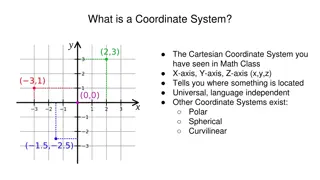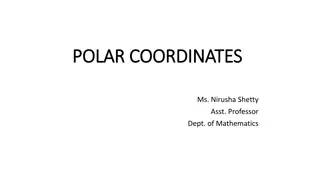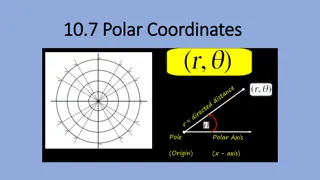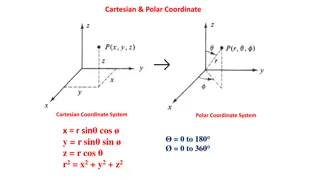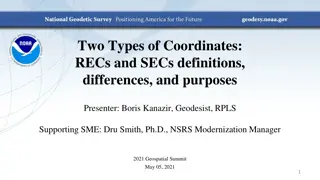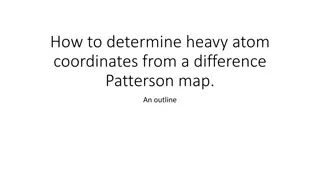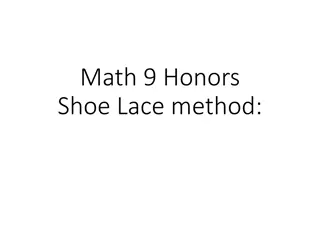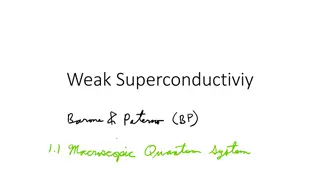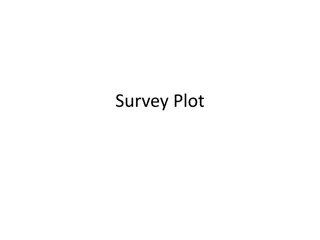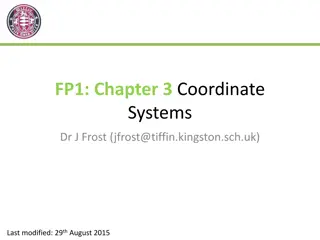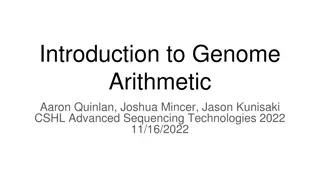Interactive Pirate Treasure Hunt with Coordinates and Directions
Explore the exciting world of pirate treasure hunting using coordinates, angles, and directions on a map. Learn how to locate hidden treasures by following clues and instructions. Try your hand at finding the treasure using different methods such as reading coordinates, moving in vectors, and naviga
2 views • 5 slides
Introduction to Cartesian Components of Vectors in Two-Dimensional Space
Exploring Cartesian components of vectors in a two-dimensional coordinate frame using unit vectors i and j. Learn how to express vectors, add them using the triangle law, use column vector notation, and find resultant vectors. Understand position vectors in terms of coordinates. Examples and diagram
2 views • 16 slides
2D Viewing in Computer Graphics
Exploring the concept of 2D viewing in computer graphics, this lecture covers the 2D viewing pipeline, including clipping, window normalization, viewport transformations, and OpenGL 2D viewing functions. It explains how a picture is defined using a Cartesian coordinate system, selecting views within
7 views • 84 slides
PowerGrid: Reconstructing High-Resolution Non-Cartesian MRI Data for Bioengineering Research
PowerGrid is a cutting-edge system developed by Brad Sutton, Assoc. Prof. at the University of Illinois, for harnessing high-performance computing to reconstruct large sets of high-resolution non-Cartesian MRI data. This technology addresses the need for improved image reconstruction packages in MRI
4 views • 10 slides
Coordinate Systems in Mathematics and Astronomy
Coordinate systems such as Cartesian, Polar, and Celestial serve as frameworks for locating points in space. They include dimensions like x, y, z axes in Cartesian, Latitude and Longitude on Earth, and various systems for astronomical observations. Different coordinate systems cater to specific purp
4 views • 11 slides
Polar Coordinates in Mathematics
Polar coordinates define the location of a point in terms of distance and angle from an origin. The distance is denoted by "r" and the angle by "?". However, the angle is not unique for a point. The concept involves fixing an origin and an initial ray, with positive angles measured counterclockwise.
3 views • 7 slides
Polar Coordinates in Mathematics
Polar coordinates provide an alternative way to plot points using a directed angle and distance from the origin. This system involves radius (distance) and angle measurements, allowing for multiple representations of points. Graphing polar coordinates, converting between polar and rectangular coordi
1 views • 19 slides
Cartesian and Polar Coordinate Systems
Explore the concepts of Cartesian and Polar coordinate systems, including their formulas and visual representations. Dive into the relationships between Cartesian and Polar coordinates, as well as their applications in mathematics and physics. Discover orbital shapes such as Px, Py, Pz, and dz2 orbi
6 views • 12 slides
Introduction to Polar Coordinates: A Different Coordinate System
Exploring the concept of polar coordinates, a coordinate system introduced in the mid-seventeenth century by notable mathematicians independently. Learn about measuring angles in radians, converting between degrees and radians, and drawing graphs in polar coordinates by considering length and angle
4 views • 34 slides
Insights into Polynomials Vanishing on Cartesian Products and the 3POL Problem
This joint work explores polynomials vanishing on Cartesian products, focusing on the 3POL problem involving three sets of points and a 6-variate polynomial. It discusses the running time of solving the explicit 3POL problem and compares it to the well-studied 3SUM problem in theoretical computer sc
2 views • 29 slides
REC and SEC Coordinates in Geodesy
Geodesist Boris Kanazir and NSRS Modernization Manager Dru Smith delve into the definitions, differences, and purposes of Reference Epoch Coordinates (RECs) and Survey Epoch Coordinates (SECs) at the 2021 Geospatial Summit. OPUS coordinates, SEC computation by NGS every four weeks, REC re-computatio
5 views • 17 slides
Deciphering Heavy Atom Coordinates from Difference Patterson Map: An Overview
Understanding how to determine heavy atom coordinates from a difference Patterson map involves recognizing the relationship between Patterson peak coordinates (u,v,w) and space group symmetry operators in crystallography. By solving equations that relate these coordinates, the absolute positions of
5 views • 5 slides
Geodetic Datums and WGS-84 Coordinates
Geodetic datums define the earth's shape and size, serving as reference points on coordinate systems. Vertical datums establish zero surface elevation, while horizontal datums form the basis for horizontal coordinates. The World Geodetic System 1984 (WGS-84) is the reference system used by GPS and l
4 views • 29 slides
Shoe Lace Method for Finding Polygon Areas
The Shoe Lace Method is a mathematical process used to determine the area of any polygon by employing coordinate geometry. By following specific steps, including organizing coordinates, multiplying diagonally, and adding columns in a certain manner, the method allows for a straightforward calculatio
11 views • 8 slides
Graphics Output Primitives and Coordinate Reference Frames
Graphics output primitives and coordinate reference frames play a crucial role in describing scenes and drawing basic geometric structures in 2D space. These concepts involve defining points, drawing lines, and understanding pixel coordinates within a coordinate system. Absolute and relative coordin
7 views • 35 slides
Weak Superconductivity and Functional Coordinates
Delve into the realm of weak superconductivity and the significance of functional coordinates in this informative presentation. Explore the intricacies of these concepts through a series of visually appealing slides that shed light on their characteristics and applications. Gain insights into the re
1 views • 8 slides
Calculating Polygon Area and Trapezium Area with Known Coordinates
The content above guides you on finding the exact area of a polygon by calculating the areas of individual triangles within it. It also demonstrates how to list coordinates in a spreadsheet, calculate the area of trapeziums formed by pairs of coordinates, and sum their areas to determine the total a
4 views • 28 slides
Equations of Motion in Local Cartesian Reference Frame
In meteorology, understanding the dynamics of wind flow is crucial. This equation describes the motion in a local Cartesian reference frame, considering factors such as gravitational acceleration and Coriolis force. It provides a mathematical framework to study atmospheric dynamics and predict weath
1 views • 5 slides
Coordinate Systems and Conic Sections in Mathematics
This content explores various coordinate systems, conic sections, parametric equations, and Cartesian equations in the field of mathematics. It covers topics such as sketching parametric curves, converting parametric to Cartesian equations, and solving exercises related to parametric equations. The
7 views • 29 slides
Introduction to FX Graph 5 - Functions, Features, and More
In this guide, discover how to use FX Graph 5 to graph functions, leverage its features like automatic point of interest detection, right-click menus, and annotations, and understand Cartesian and Inverse Cartesian functions. Learn about the function entry system and setting axes to create accurate
1 views • 40 slides
Coordinates in Geometry
Coordinates in geometry are used to represent specific positions on a coordinate plane. This involves assigning an order to points in all quadrants, understanding the x-axis and y-axis, plotting points accurately, and determining the coordinates of various shapes. By learning to read and plot coordi
2 views • 13 slides
Geometry Focus: Reflections, Translations & Coordinates in Year 5
Explore the concepts of reflections, translations, and coordinates in geometry with a focus on shapes in the first quadrant. Learn how to identify, describe, and represent shape positions following transformations. Key vocabulary like reflection, translation, and coordinates will be covered. Enhance
4 views • 33 slides
Introduction to Genome Arithmetic and Coordinates
In this presentation, delve into the realm of genome arithmetic and coordinates through insightful discussions on reference genomes, functional consequences of variants, and designing sequencing panels. Explore the significance of genome coordinates in identifying specific locations within a referen
2 views • 25 slides
Complex Numbers: Cartesian vs Polar Form, Graphical Representation, Operations
Learn about complex numbers in Cartesian and polar forms, Euler's identity, graphical representation on a complex number plane, arithmetic operations, and conversion between forms. Explore examples and concepts related to complex numbers in the context of electric circuits and engineering.
0 views • 7 slides
3D Cartesian Coordinates and Vector Calculations for Mathematics Enthusiasts
Dive into the world of 3D Cartesian coordinates and vector calculations with this detailed guide. Learn how to find distances, magnitudes, and unit vectors in three dimensions. Practice exercises included!
3 views • 40 slides
Polar Coordinates and Conversions
Explore the concept of polar coordinates, multiple representations, negative r values, and conversion between rectangular and polar coordinates. Learn how to determine which point does not represent the same coordinates as others in a given set.
3 views • 53 slides
Coordinate Geometry: Naming Vertices, Using Variables
Explore coordinate geometry concepts by naming vertices of figures and using variables for coordinates. Understand how to identify and work with coordinates efficiently. Dive into Problem 1 to name vertices and Problem 2 to use variable coordinates effectively in various figures.
2 views • 6 slides
Cylindrical Coordinates in Advanced Mathematics
Explore the concept of cylindrical coordinates, a three-dimensional coordinate system used to specify a point's location based on radial distance, azimuthal angle, and height. Learn about conversions between cylindrical and Cartesian coordinates, along with practical applications in various fields l
1 views • 20 slides
Directional Derivatives and Gradient Vectors in Advanced Mathematics
Explore directional derivatives, gradient vectors, and examples on cylindrical coordinates in advanced mathematics under the guidance of Dr. Mazin R. Khalil. Dive into the conversion of cylindrical coordinates to rectangular coordinates and enhance your understanding of mathematical concepts.
2 views • 30 slides
Differential Equations for Heat Conduction in Different Coordinates
Explore the general differential equations for heat conduction in Cartesian and cylindrical coordinates, along with steady state conditions and Laplace equation. Fourier's law of heat conduction and the thermal diffusivity are discussed, providing a comprehensive overview of heat conduction principl
0 views • 7 slides
Coordinates and Equations in Graphs
Explore the concept of coordinates and equations on a graph through various examples such as finding coordinates on a line, plotting points based on equations, and interpreting the relationships between x and y coordinates. Practice and enhance your graphing skills with interactive visuals.
2 views • 34 slides
Understanding Cartesian Coordinates and Linear Functions
Explore the concepts of Cartesian coordinates, gradients, linear functions, and relationships between lines in two dimensions. Learn about slopes, intercepts, and parallel/perpendicular lines through detailed explanations and examples.
1 views • 25 slides
High-Order Cartesian Discontinuous Galerkin Solver for Conjugate Heat Transfer
Explore the innovative Cartesian extended discontinuous Galerkin solver for conjugate heat transfer, addressing challenges like complex geometry and multiphysics coupling. The methodology involves high-order DG on Cartesian grid with cut-cells for strong coupling. Discover the approach to tackling a
0 views • 21 slides
Generalized Coordinates and Degree of Freedom in Physics
Explore the concept of generalized coordinates and degree of freedom in physics, understanding how holonomic constraints affect the number of independent coordinates needed to describe a system. Learn about the degrees of freedom for systems like a simple pendulum and particles moving on a sphere, a
0 views • 12 slides
Using Table Mode for Function Coordinates
Learn how to find the coordinates of a function by using the table mode feature. Explore graphing functions, changing calculator modes, and step-by-step processes to determine coordinates within a specified domain. Enhance your understanding of function analysis and graph plotting with practical exa
0 views • 7 slides
Uncover Pirate Treasures with Halloween-themed Map Challenges
Embark on a Halloween treasure hunt using coordinates, angles, and directions to locate pirate treasure on a map. Learn to read positions, follow vector coordinates, and use polar coordinates to find hidden gems. Enjoy the adventure with engaging worksheets included.
0 views • 5 slides
Understanding REC and SEC Coordinates in Geodesy
Explore the differences and purposes of Reference Epoch Coordinates (RECs) and Survey Epoch Coordinates (SECs) in geodesy, covering how they are computed, updated, and used by NGS. Learn how OPUS coordinates tie into the NSRS, the time dependency of SECs, and the re-computation cycle of RECs.
0 views • 17 slides
Complex Numbers in Digital Signal Processing - Understanding Polar Coordinates
Learn about complex numbers and polar coordinates in the context of digital signal processing. Discover how to convert between Cartesian and polar coordinates using MATLAB functions for efficient signal processing applications.
0 views • 5 slides
Rectangle Properties and Transformations Explained
Explore the concept of rectangles through identifying missing coordinates, calculating perimeter, and investigating translations. Challenge yourself to draw rectangles with the same dimensions in different locations and understand the changes in coordinates through translations. Engage in discussion
2 views • 23 slides
Electrodynamics Lecture 8: Multipole Moment Expansion
Explore the multipole moment expansion of electrostatic potential in spherical and Cartesian coordinates. Dive into Poisson and Laplace equations in spherical polar coordinates, spherical harmonic functions, Legendre polynomials, and associated Legendre functions. Gain insight into useful identities
1 views • 23 slides




